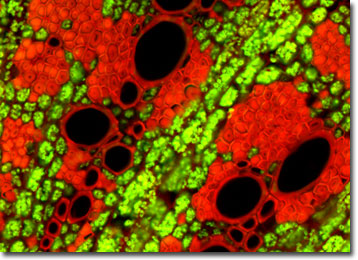Fluorescence Digital Image Gallery
Alfalfa Root
Alfalfa, or Medicago sativa, is a deep-rooted perennial native to the Mediterranean region near Iran but which also grows well in North America and Western Asia. Also called Lucerne, or Purple Medic, it looks very much like clover with a smooth, erect stem growing 2 to 3 feet tall, grayish-green feathery trifoliate leaves, and egg-shaped leaflets. It is tolerant of a wide range of climatic conditions and can be grown in cool, humid environments as well as irrigated arid regions.

Ancient Chinese doctors used alfalfa to increase appetite and to help poor digestion. Modern day herbalists promote it for detoxification believing that it can help relieve certain types of ulcers, reduce inflammation due to arthritis, treat high fevers, cleanse the liver and bloodstream, and alleviate allergic reactions related to plants and grasses. There are few if any valid scientific studies to support these claims, however, it's proven as an excellent source of vitamins, minerals, fiber, proteins, and fats and is especially rich in the amino acid tryptophan, iron, and vitamins A, D and K.
High vitamin and mineral content is one of the reasons alfalfa is popular among farmers and planted in over 25 million acres in the United States. When alfalfa is cut prior to bloom, it is low in fiber and high in energy, which makes it an ideal component in livestock feed for dairy cattle, horses, beef cattle, sheep, and milking goats. It also has a very high yield potential, garnering it the name "Queen of Forage." Also, it plays an integral role in crop rotations because it improves tilth (soil structure), helps control weeds in subsequent crops, and also can help reduce the risk of nitrate contamination of ground water supplies by extracting nitrate from the subsoil beneath the average rooting zone.
Alfalfa has a good yield, but it can be a costly crop to grow. Annual dollar loses due to pests and disease run in the hundreds of millions. The potato leafhopper is the most problematic insect, yellowing the foliage and stunting stems in the crops of the central and eastern regions of the United States. More that 20 diseases are a serious problem for alfalfa including bacterial wilts, fungal leaf spots, viruses, and nematodes. Most of these can be managed with proper treatment and pesticides.
The specimen presented here was imaged with a Nikon Eclipse E600 microscope operating with fluorite and/or apochromatic objectives and vertical illuminator equipped with a mercury arc lamp. Specimens were illuminated through Nikon dichromatic filter blocks containing interference filters and a dichroic mirror and imaged with standard epi-fluorescence techniques. Specific filters for the alfalfa thin section were a B-2E/C and a Y-2E/C. Photomicrographs were captured with a Nikon DXM 1200 digital camera system coupled to the microscope with a lens-free C-mount adapter.
BACK TO THE FLUORESCENCE DIGITAL IMAGE GALLERY
